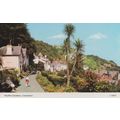Von Herkomer, Hubert - Hard Times 1885 - art postcard
- Condition : Used
- Dispatch : 2 Days
- Brand : None
- ID# : 200113718
- Quantity : 1 item
- Views : 266
- Location : United Kingdom

- Seller : justthebook (+1703)
- Barcode : None
- Start : Sat 10 Apr 2021 01:36:55 (BST)
- Close : Run Until Sold
- Remain : Run Until Sold
More Listings from This Seller view all
Seller's Description
- Art Postcard
- Work of art title: Hard Times, 1885
- Artist (if known): Sir Hubert von Herkomer (1849-1914)
- Media or other details: painting
- Publisher / Gallery: City of Manchester Art Galleries
- Postally used:
- Stamp & postmark details (if relevant):
- Size: Modern
- Notes & condition details:
NOTES:
Size: 'Modern' is usually around 6in x 4in or larger / 'Old Standard' is usually around 5½in x 3½in. Larger sizes mentioned, but if you need to know the exact size please ask as this can vary.
All postcards are not totally new and are pre-owned. It's inevitable that older cards may show signs of ageing and use, particularly if sent through the post. Any faults other than normal ageing are noted.
Stock No.:
Please ask if you need any other information and I will do the best I can to answer.
------------------------------------------------
Postage and packing charge should be showing for your location (contact if not sure).
UK - PayPal, Cheque (from UK bank) or postal order
I will give a full refund if you are not fully satisfied with the postcard.
----------------------------------------------
Sir Hubert von Herkomer CVO RA (born as Hubert Herkomer; 26 May 1849 – 31 March 1914) was a Bavarian-born British painter, pioneering film-director, and composer. Though a very successful portrait artist, especially of men, he is mainly remembered for his earlier works that took a realistic approach to the conditions of life of the poor. Hard Times (1885; Manchester Art Gallery) showing the distraught family of a travelling day-labourer at the side of a road, is one of his best-known works.
In the same year in 1869, he also began working as an illustrator for the newly founded newspaper The Graphic, a deliberate rival of the Illustrated London News. It was by his oil painting The Last Muster (1875), after a wood-engraving of 1871, that he established his position as an artist of high distinction at the Academy. He was elected an associate of the Academy in 1879 and an academician in 1890, an associate of the Royal Watercolour Society in 1893 and a full member in 1894. In 1885 he was appointed Slade Professor of Fine Art at the University of Oxford, a position he held until 1894. He was the first president of the Oxford Art Society, established in 1891.[2]
In 1899, Herkomer was ennobled as "Ritter von Herkomer" by Otto of Bavaria, who appointed him Knight of the Merit Order of the Bavarian Crown. The same year, he was awarded the Pour le Mérite for Arts by Emperor Wilhelm II of Germany.
On her deathbed, Queen Victoria was initially photographed in study and eventually painted by Herkomer as an alternative to the more traditional mask produced in wax, which her son, the new king Edward VII, decried. The painting, showing the Queen lying half-length among lilies and other flowers, swathed in white tulle, her right hand holding a cross, is part of the Royal Collection held at Osborne House on the Isle of Wight, where it hangs in the Pavilion Principal Stairs Vestibule. In 1907, Herkomer was knighted by King Edward VII.
Herkomer exhibited a very large number of memorable portraits, figure subjects, and landscapes, both in oil and watercolour; he achieved marked success as a worker in enamel, as an etcher, a mezzotint engraver, and an illustrative draughtsman and he exercised wide influence upon art education by means of the Herkomer School (Incorporated) at Bushey, which he founded in 1883 and directed without payment until 1904, when he retired. It was voluntarily wound up in 1926 having been run up to that time by Lucy Kemp-Welch, and is now defunct.
Despite being a prominent member of Royal Academy of Arts, Royal Watercolour Society, and Royal Society of Painter-Etchers, as well as being on familiar terms with the royal family, Herkomer was never totally accepted by the British establishment, as he was ultimately a victim of the deteriorating relationship of Great Britain and Germany, which he shuttled in between, spending most of his summers in Bavaria.
Herkomer's massive house, Lululaund, named after 'Lulu Griffith, the second of his three wives, served as his studio, school, theatre, and movie studio, where he put on productions of his own plays and musical compositions. It was designed by the prominent American architect Henry Hobson Richardson, for whom Herkomer painted a portrait.
Four of his pictures, Found (1885), Sir Henry Tate (1897), Portrait of Lady Tate (1899) and The Council of the Royal Academy (1908), are in the national collection at the Tate Gallery. In 1907, he received the honorary degree of Doctor of Civil Law at Oxford, and a knighthood was conferred upon him by the king in addition to the commandership of the Royal Victorian Order with which he was already decorated.
Herkomer was also a pioneering filmmaker. He established a studio at Lululaund and directed some seven historical costume dramas designed to be shown accompanied by his own music, but none of them seems to have survived.
He had strong connections with Wales. His second wife hailed from Ruthin and he spent lengthy periods in Snowdonia painting with his friend, Charles Mansel Lewis from Stradey Castle, Llanelli.[3] In 1899, he designed the Grand Sword of the Gorsedd of Bards, and he also designed some of its other regalia.[4]
Listing Information
| Listing Type | Gallery Listing |
| Listing ID# | 200113718 |
| Start Time | Sat 10 Apr 2021 01:36:55 (BST) |
| Close Time | Run Until Sold |
| Starting Bid | Fixed Price (no bidding) |
| Item Condition | Used |
| Bids | 0 |
| Views | 266 |
| Dispatch Time | 2 Days |
| Quantity | 1 |
| Location | United Kingdom |
| Auto Extend | No |



 for 1 item(s)
for 1 item(s)


![Van Gogh, Vincent - Sunflowers [4th] - National Gallery art postcard c.1960s](https://pic.ebid.net/upload_medium/2/7/0/1424731301-1918-150.jpg)











